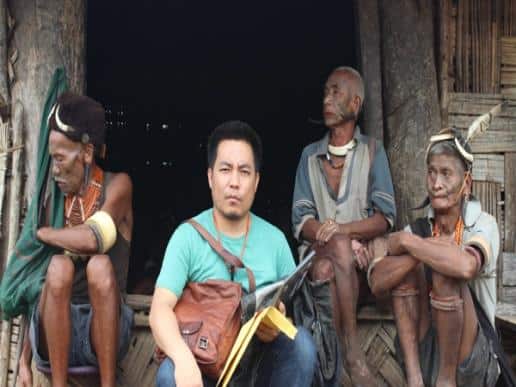New Delhi: Traditional tattoos were once considered marks of beauty, valour, pride and belief where one could identify a person through lines and tattoo patterns.
But now in some parts of the country, indigenous people have forgotten that they were once a tattooing community, while some communities’ abandoned the practice of tattooing 50-60 years ago because of the advent of a new religion or a new way of life without really understanding the importance of it.
Aiming to revive India’s indigenous tattoo traditions and planning to take it forward to give indigenous tattoo craft a deeper meaning, a young Naga tattoo researcher and revivalist, Moranngam Khaling, alias Mo Naga, has launched country’s first conceptualized tattoo studio tilted ‘Godna Gram-The Tattoo Village’ in New Delhi.
This new mission and a new venture came through after an intensive four years of research and travelling which took him mostly to the interior villages bordering Myanmar to search for the dying tribal tattoo art of the northeastern states, says Mo Naga.
The studio will project itself as a one-stop centre to build a global connect and also invite tattoo artists from other parts of the country to practice and promote their art.
“Godna Gram is for the whole of India. So, we will encourage and train artists. We will help them set up studios and help them to do research and revive their tradition in different parts of India but at the same time, we will always have a space for them to come and promote their art in the capital city of India,” added Mo Naga.
Trained as a fashion designer at the National Institute of Fashion Technology in Hyderabad, his true calling for recreating the art and culture of indigenous people through contemporary renditions of traditional patterns and responsible tattooing happened in the year 2002.
“If Nagas identify and differentiate themselves with the pattern of cloths, then tattoos were there before that. So, the more I started study and research, the more I realized that this is where I can contribute to society as an artist, as a cultural enthusiast, as a person who loves their people. So, that’s why I started and became a full time tattoo artist,” Mo Naga said.
After years of practice as a professional tattoo artist, he left New Delhi in 2013 and set up his first tattoo studio ‘Headhunters Ink’ in Guwahati-the gateway city to Naga homeland which later re-located to Nagaland.
The first studio was born out of his love and passion to study, preserve and promote the unique identities of Nagas through art and design culture.
His work for attempting to restore the vanishing tattooing convention of different tribes of Nagaland and Nagas as a whole makes him the only Indian to feature in the “Tattoo Masters Flash Collection”. He was also featured as one of the top 100 artists of the World in “The World Atlas of Tattoo”.
The ethnic significance of Mo Naga’s work has intrigued and inspired many from the country as well as across the globe.
“I really liked it, especially the idea about the research he has done that this is something which is not there before and doing this called Neo Naga through arts. So, he’s implementing his own ideas in the existing traditional tattoos which are taken from the tribes and also implementing from some patterns from wood carvings and so on,” added Daniel, a German client.
Henceforth, with knowledge, creativity, hard work and plenty of talent, Mo Naga plans to bring about great innovative change in reviving India’s fading ink. (ANI)

